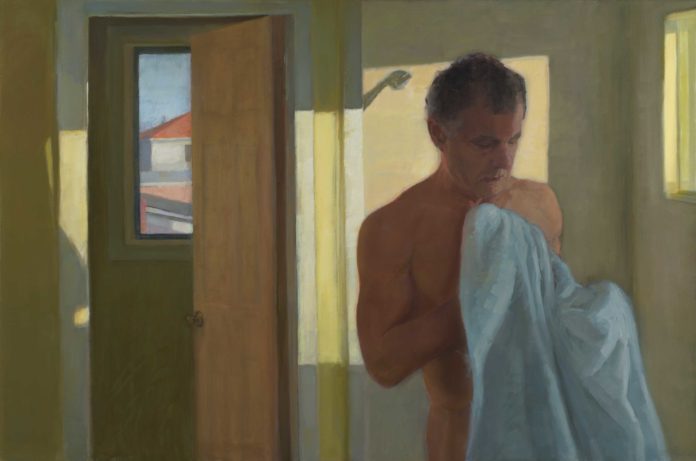“By examining my own world and people closest to me on a daily basis, my paintings have begun to reflect the current season of my life.”
Familiar
BY SALLY STRAND
“Great art is the outward expression of an inner life in the artist, and this inner life will result in his personal vision of the world.” – Edward Hopper
Everyday Life
I relate to small moments of life that are often overlooked. These moments resonate with me because they are familiar—we see ourselves in them. They sometimes suggest things beyond the obvious. Painting mundane objects or tasks provides me with a challenge to portray the commonplace in a compelling way, to make the usual unusual and worthy of notice.
In my current body of work I have painted my family and myself living daily life at home and in familiar locations. My preference is to depict people reacting in the moment to things that are around them, and without a sense of drama. This provides a feeling of repose, tapping into a sense of simplicity, privacy, silence, and serenity. I move away from idealized forms by more closely adhering to physical appearances in nature. I attempt to create a mood, to make feelings and emotions visual.
To that end, I am increasingly looking for what is underneath, what is unseen or hidden instead of only considering the physical appearances of things or my technical skills as an artist. Focusing more on my own feelings and experiences, instead of outward appearances characterized by a display of craft, is helping me to show more of myself in my work.
By examining my own world and people closest to me on a daily basis, my paintings have begun to reflect the current season of my life. My two sons are now grown and have moved away. My husband and I are now caring for our aging parents, including my 87-year-old mother, an artist who appears in several of my oil paintings and in one pastel painting. In Harriet, she was moving out of her condo to a senior facility.
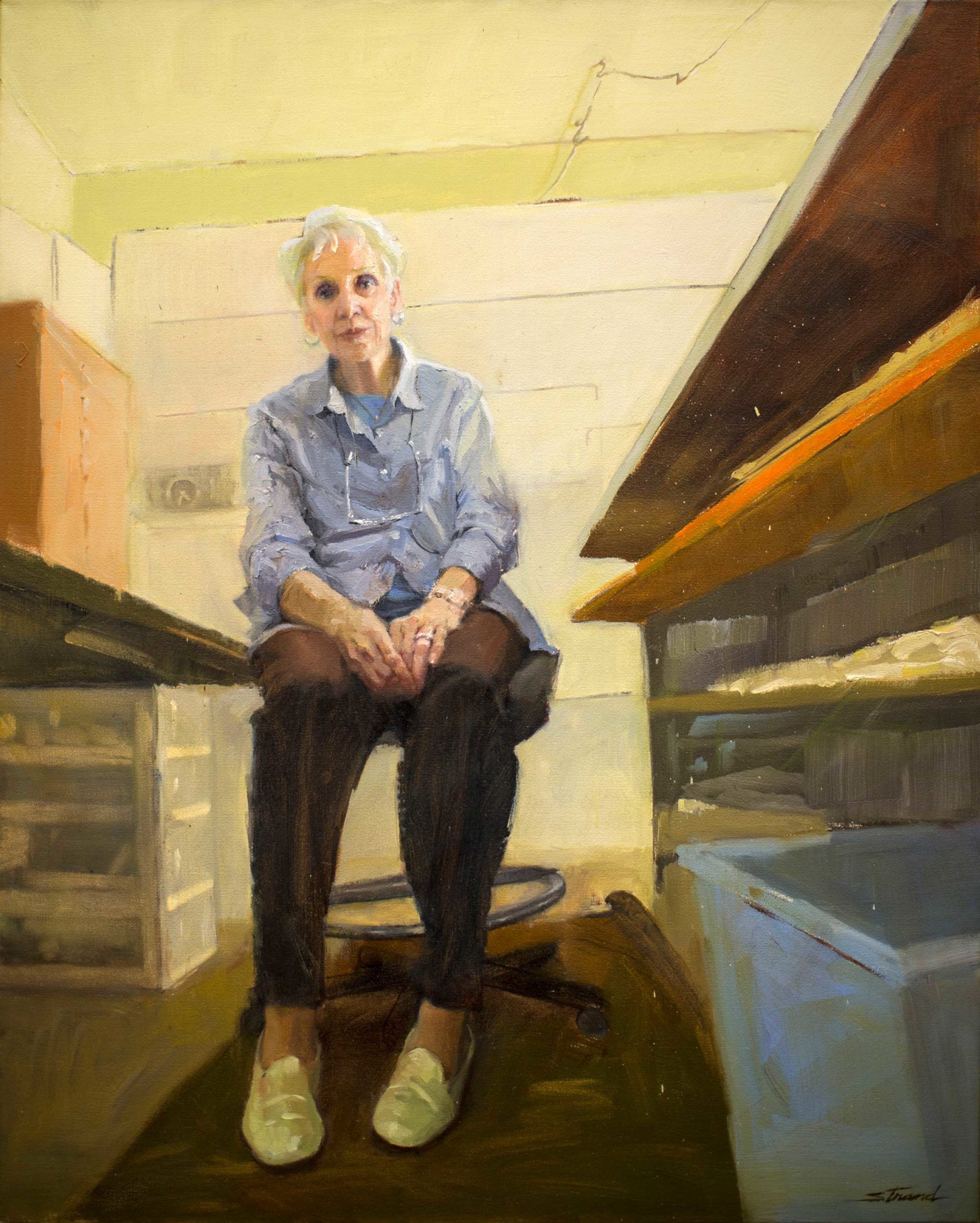
This involved taking apart her art studio and selling art equipment collected over many decades. It was a great sorrow to us all. Having grown up in my mother’s art studio, I placed the position of the viewer down low looking up at her in place of myself as a child. In the painting, the studio shelves are bare, with strong diagonals from the tables pointing to my mother’s hands. I showed this painting in a lecture at a workshop. A startled woman in the audience turned around with a deeply concerned look on her face, and exclaimed, “She looks lost.” Again, I felt the painting had tapped into something meaningful and generated more of an emotional response from viewers than had my previous work.
Another painting, entitled “Window,” came out of the same period when moving my mother from her home. I painted my mother outside her kitchen, washing a window. The viewer is inside looking out through the window, back at my mother, seeing her face as she scrubs, with suds and water dripping down the windowpane. This painting, rendered with pastel on paper, won an award at an exhibition in New York City and was published in a national magazine.
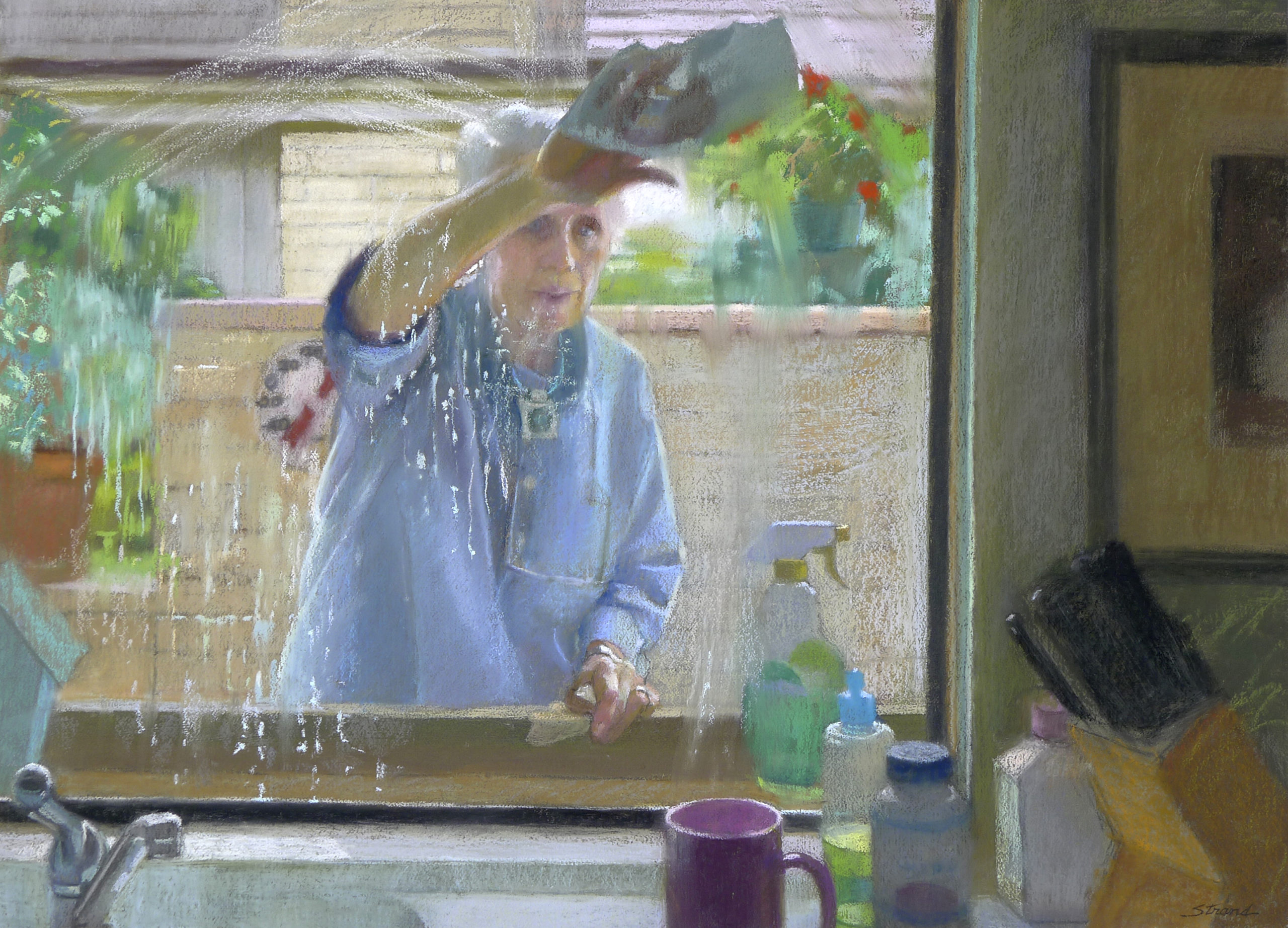
I received many emails and letters from viewers telling me their personal stories and memories about their mothers, as well as about how they related to such a commonplace but overlooked event. For some, the painting generated warm remembrances while others were bittersweet or sad. One man at the exhibition told me he glanced at my painting and knew it would be awhile before he could get up the nerve to really look at it due to his own memories of his mother.
Human Themes
In the same way that I have been drawn to genre paintings of everyday life, I am looking at those things that make us human and are shared by all, such as relationships with other people. Last summer, my husband and I spent several weeks in a modest Paris apartment loaned to us by another artist. Daily afternoon sunshine streamed into the small main room. An elevated urban landscape of buildings could be seen through the windows.
I chose this unadorned space as the setting for a large oil painting entitled “Interval,” using myself as the woman seated at a table, writing, pen in hand, gazing and pausing as if in mid-sentence. Across the table from her, an empty chair is pushed aside.
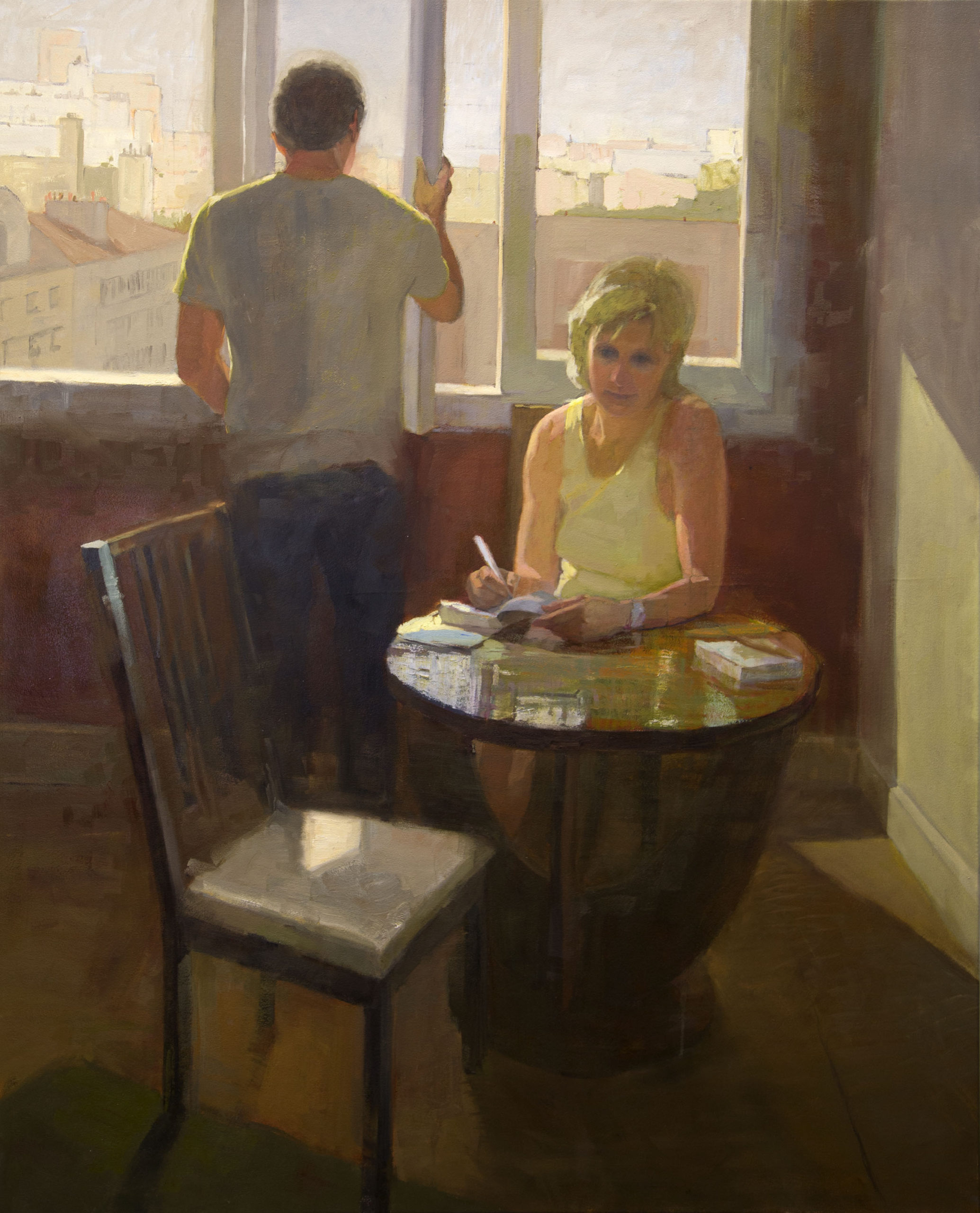
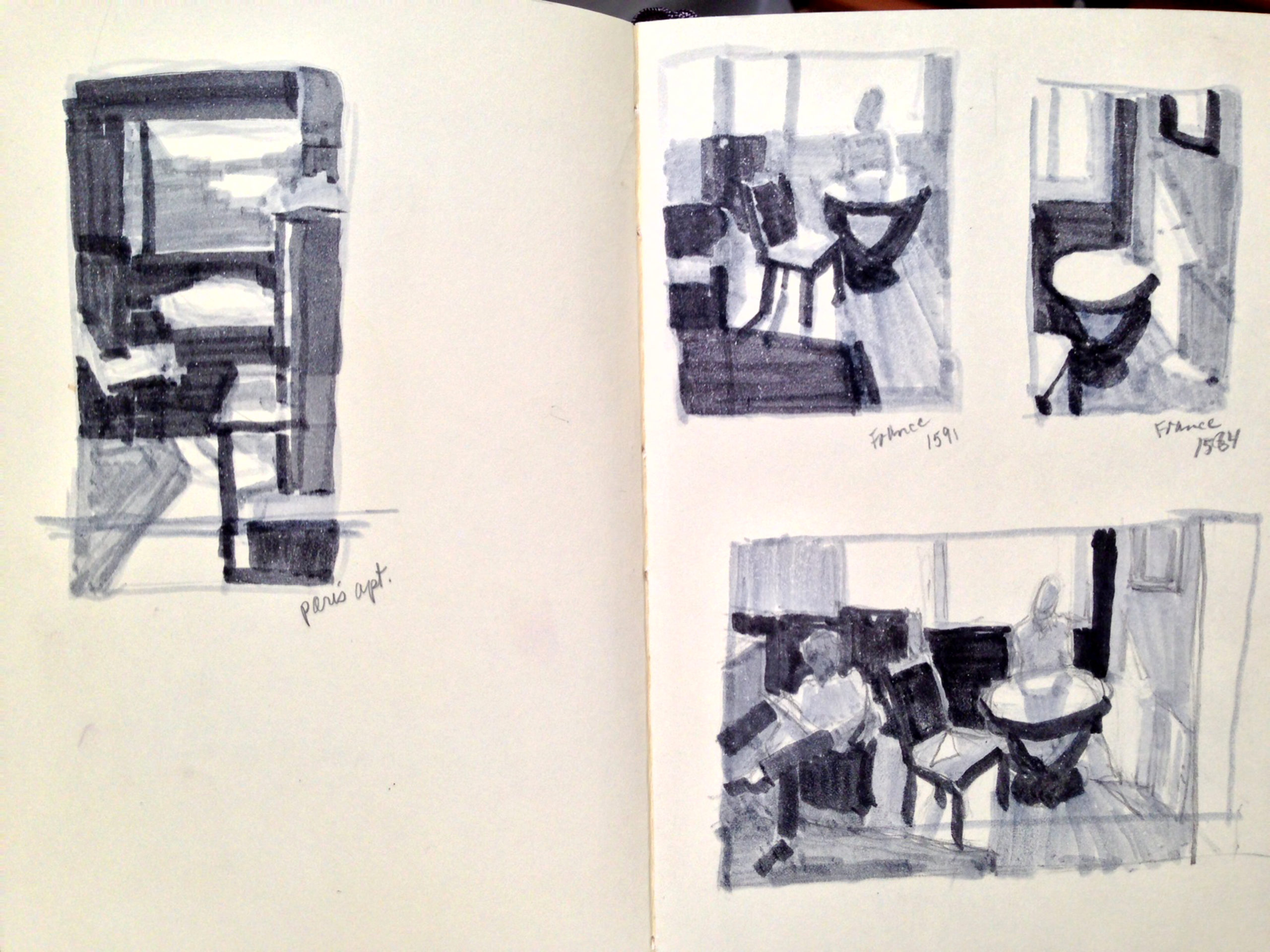
Eventually, I decided to change the dynamic by adding the figure of a man standing slightly behind her. The man, turned away, faces outwards toward the city with one hand on the sill of a slightly open window; next to the woman a strong shaft of light streams across the wall and onto the floor.
Several viewers approached me at various times throughout the course of the museum exhibition of this painting to express strong reactions to it. Unsolicited, they offered me their interpretations of what was happening between the two figures in the painting and created personal narratives of their own, some very agitated and seemingly troubled. These reactions surprised me because the viewers sincerely wanted to discuss possible interpretations, asking questions such as, “What’s going on?” “Why aren’t they talking?” “Did something just happen between them?”
Even though these responses were not what I intended in the painting, I was intrigued and glad to have provoked responses in viewers, unlike other comments I have heard about my work, which were often technical or stylistic remarks. I felt I had tapped into a deeper level of emotion for the viewer—that it was thought provoking and left room for interpretation. Although I am not certain I will continue to try to use psychology in my paintings to elicit responses, I was gratified to know that my work can function in this manner.
Time
Turning homeward to paint myself, my aging mother, my husband and grown children has refocused attention on my view of time and how I use it in my artwork. Previously, I painted people unknown to me in public spaces caught in singular moments in the business of living. I also painted still life objects caught in a moment and touched by a shaft of moving light. A solo museum exhibition featuring a survey of many years of my work was titled, “Sally Strand: Fleeting Moments.” My treatment of the temporal in my art at that time was more limited and not informed by the sweep of art history.
More recently, I created a painting entitled “Front Page,” which was a departure from any of my previous works. Here, time passing is represented through movement and simultaneity in this single image. The composition features my adult son in multiple transparent states of overlapping motion, turning to pick up a newspaper from a table while my husband emerges from a background doorway in another room.
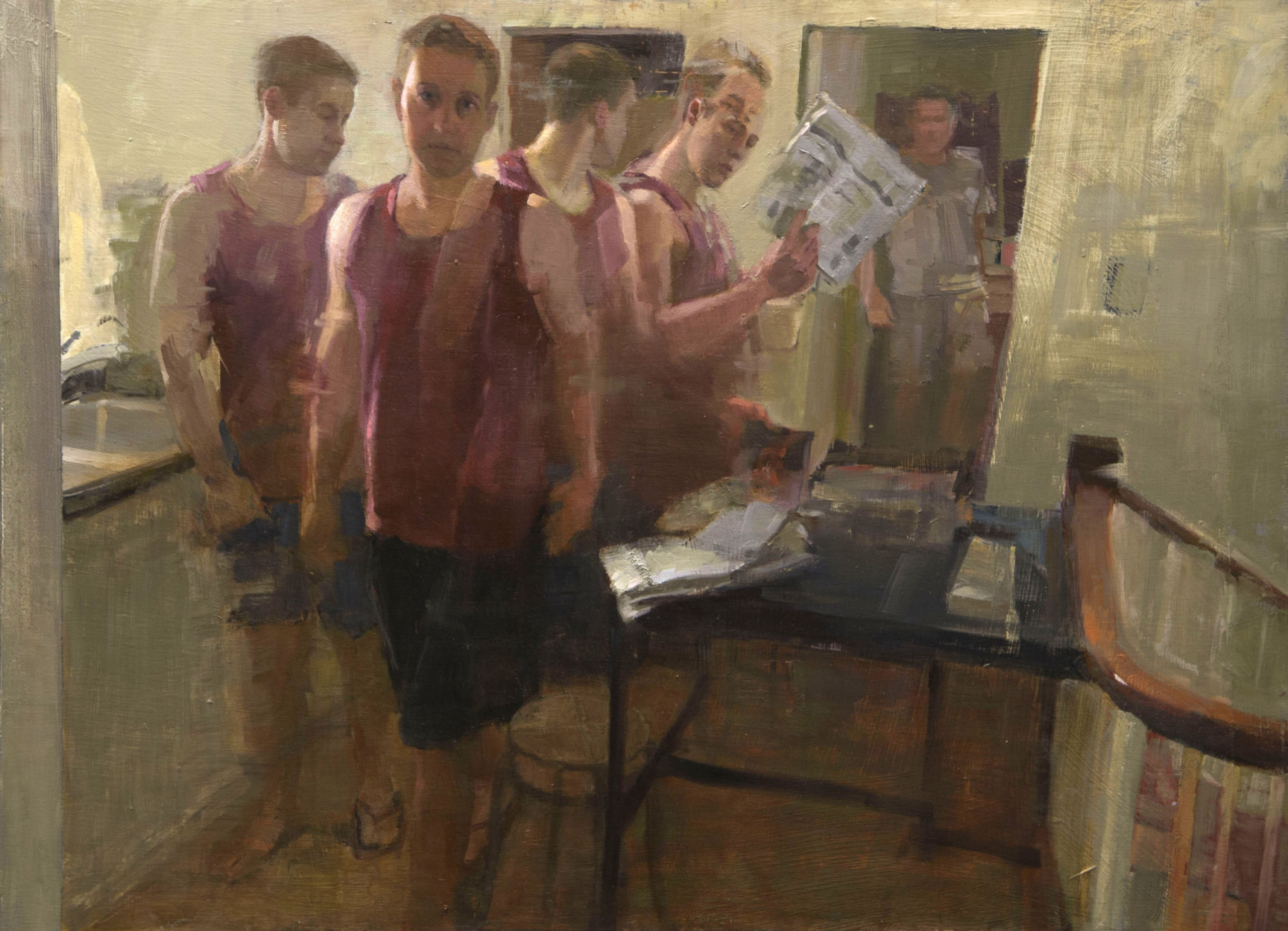
I observed my family moving around and going through various morning routines. I focused on the moment my son was turning to pick up and glance at the front page of a newspaper while my husband addressed him from another room. A suggested narrative is evoked by the figures’ passage through time, albeit briefly, which is not fixed or extended as if models were posing.
Such was the feeling I had in developing the idea for “Vacation.” All too rare now are the times when our family is together. Our sons have jobs and lives of their own. Carving out time to be together, unhurried and slow, is difficult. Last summer, we managed to get away together for a few days, renting the upper floor apartment of an old Victorian house. One morning I focused, wistfully, on the familiar rhythms and routines of our family, noting feelings of sadness mixed with gratitude for the rare moment of familial togetherness. Even seemingly inconsequential traditions and routines link us to our past, to our heritage, our identity as a family.


I found myself wanting to reflect on the continuum of our relationship as a family over time. “Vacation” developed out of this desire. It is a panorama painted on three long, adjacent canvases. In addition to the theme of momentary togetherness, this painting also has a secondary motif of opposites: male and female, young and old, inside and outside, openings and exits, light and dark.
My family is engaged in leisurely yet typical breakfast routines. Using the same room as in my previous painting, “Front Page,” I expanded the composition to a wide format with simultaneous views from left to right of additional rooms, a series of openings and exits. Each family member is momentarily engaged in their own activities, turned inward, together yet alone.
Behind my son reading at the table, a descending stairway leads the viewer’s eye down to a window. The stairway going down echoes the feeling of going down into the sink and down the black drain, prominently displayed. To the left of the stairs extending onto the left panel, my mother is seen with her hand on a cane, moving to the right, back into the composition, out of a darkened bedroom.
Although she was not with us at the time, her aged presence in the scene draws a contrast in time to the younger family members and to the sunny light-filled bedroom at the opposite side of the painting. The differing light in the various room sections alludes to the nature and passage of time as we move from youth to old age and through the seasons of life in a family.
The theme of everyday life, or “genre painting” as it came to be known, has a rich tradition in art history. Only recently has it become clear to me that observing the routines of daily life connects my work to a long and significant thread through centuries of art: a common but necessary need to connect and reflect on the human condition.
The first real awakening of my interest in visually observing daily life began on a train ride in Europe while traveling in college. I looked out the window and saw immigrants walking, burdened, and bent over with boxes on their shoulders. I took out paper and began to sketch them.
During the years I was studying art, representational or realist art was considered outmoded and dead. Living in New York, I sought out the few artists I could find who were working in opposition to the mainstream. I was gravitating primarily to artworks of a realistic style, but at the time, I didn’t fully understand what element of realism was holding my attention.
Now I understand that while I was certainly drawn to identifiable imagery, I was most compelled to look at works of art containing everyday life themes. More specifically, my subject matter became focused on the “moment” and then, increasingly, capturing the effects of light. Eventually, however, I began to feel discontented; this did not seem enough. I began to shift my attention to layers of meaning, to sense the inherent hidden within the mundane.
Of paramount interest to me are the formal qualities of space and shape. The seeds of my work are increasingly based on the combination of and resolution between figurative works and abstract spaces. I hope this formal synergy will provide the personal poetry and evocation of mood in my work.
In large ways, it is profoundly important for me to have gained an understanding of my inner instincts as an artist. I now understand that I am a formalist with a pull toward combining naturalistic figuration and abstract shapes for poetic expression and a mood.
My natural touch and perceptual painting process is direct, and for me, it is as much about paint itself as about depicting an illusion. My view is toward a subtle, suggested narrative. Going forward, this new self-knowledge will inform my artwork in the years to come.
Learn more about Sally Strand at: www.sallystrand.com
This article was originally published in 2015


